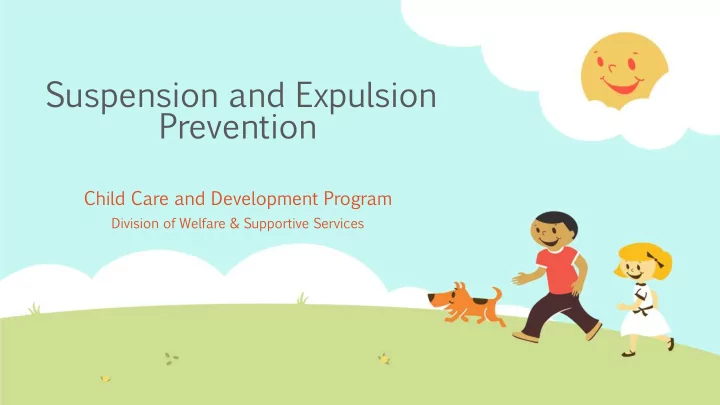

Suspension and Expulsion Prevention Child Care and Development Program Division of Welfare & Supportive Services
What is the Child Care and Development Program? • The Child Care and Development Program (CCDP) administers the Child Care and Development Block Grant (CCDBG). • This is a federal grant through the Administration of Children and Families (ACF), Office of Child Care (OCC). • In order to receive this grant, states must submit a State Plan every three years. • The State Plan allows states to inform ACF as to how they are implementing policy based on federal regulations.
How does CCDP provide assistance to families? • The CCDP assists families by using the block grant to subsidize the cost of child care. Our program reimburses providers based on reimbursement rates that vary depending on age of child and county, as well as QRIS star ratings. • The CCDP contracts with two nonprofit agencies that work directly with families and providers. These agencies are responsible for subsidy eligibility determination for families and child care resource and referral services for providers. • The Children’s Cabinet provides these services in the North and in rural areas of Nevada. • The Las Vegas Urban League provides these services in the South.
What is the purpose of this funding? • Before Welfare Reform in the mid-nineties, there were four federally funded child care programs – with th four separ arate te sets of rules! ▪ Three of them were Welfare-related: at risk for, on, and transitioning off of AFDC (assistance for families with dependent children) and the original CCDBG which was created for low income working families that were not connected to the Welfare system. ▪ A portion of the CCDBG was allocated toward quality and supply of child care. • Essentially, the purpose of all of them: making child care affordable so that parents could work.
Welfare Reform • The 1996 Personal Responsibility and Work Opportunity Reconciliation Act (PRWORA) repealed and replaced the three Welfare related programs and combined them into a blended entitlement fund with the block grant subject to the rules of the original CCDBG. The over-arching focus continued to be, mainly, helping parents become ▪ self-sufficient.
Changes in Program Focus
Multigenerational Focus There has been a shift in strategy and how we serve our families. o 2014 Reauthorization: ▪ Mandatory QRIS ▪ Comprehensive Background Checks ▪ Health and Safety Trainings ▪ Group Size and Ratio ▪ Continuity of Care ▪ And More!
Continuity of Care • High quality relationship-based care is central to optimal early brain development, emotional regulation, and learning. Continuity of care practices support the development of secure attachments and strong positive relationships as well as a secure base for exploration and learning. Research shows that attachment security significantly contributes to children’s long -range social-emotional development and self-confidence. o Examples of Continuity of Care: • 12 months eligibility – no negative action • Subsidy based on enrollment rather than attendance • Expulsion and suspension prevention
Research has shown the following…
Disparity : Myths and Facts Myth: Disparities aren’t really due to race, class, or sexual orientation; they are really about the challenges of poverty, inadequate home lives, and violent communities. Fact: Poverty does not fully explain racial disparities; school factors are stronger predictors of disparities than individual student factors or the reasons students are suspended for.
Disparity : Myths and Facts Myth: Racial disparities are really due to worse behavior among students of color. Fact: There is no evidence that racial disparities in discipline are due to higher rates of misbehavior by Black students; if anything those students are punished more severely for similar or less serious behaviors than their peers.
Disparity : Myths and Facts Myth: Suspension and expulsion are used infrequently to prevent or punish serious acts of misbehavior. Fact: Exclusionary discipline is actually used extensively, especially for Black males: 1/3 to 1/2 of all students will experience at least one suspension or expulsion during their K-12 careers; moreover, nearly 70% of Black males will experience at least one suspension or expulsion while in school. Suspension is used mostly for non-safety threatening incidents; the greatest disproportionality in discipline for Black students is based on subjective and relational- based issues such as “defiance” and “disruptive behavior”.
Support for Providers
Required Training The Technical Assistance Center for Social-Emotional Intervention (TACSEI) will provide training. At least one designated staff member with a leadership role must complete the training. Providers can choose between: ▪ TACSEI ePyramid training; or ▪ TACSEI in-person training covering modules 1-3.
Implementation of Training Content The designated staff member will facilitate implementation of methods that promote social-emotional development, including building positive relationships, creating supportive environments, and facilitating social-emotional teaching strategies amongst the staff in their child care center.
Ongoing Scheduled Support Childcare Information and Resource Phone Support (CHIRPS) community of practice phone conferences with a Pyramid Model Specialist will be regularly scheduled to provide a platform for group discussions and support with implementation of the training content.
Real-Time Support A support hotline will be available for immediate assistance from a Pyramid Model Specialist.
In-Person Training Staff must attend an in-person TACSEI training on Pyramid Model Module 3 content prior to a temporary or permanent removal of a child from their program.
Caveat! If a provider has had prior approval from the CCDP to use a different positive discipline model or if a provider has already implemented TACSEI in their program, they may not be subject to all of the steps of support in this policy/process. Note: If a provider is approved to use a different model, CCDP will not be responsible for the cost associated with that training model.
QUESTIONS?
Recommend
More recommend